The Best Beginner’s Guide to Mindfulness Meditation
Have a hard time sitting still? Our beginner’s guide to mindfulness meditation will help stop those racing thoughts long enough for your body to take a restorative pause.
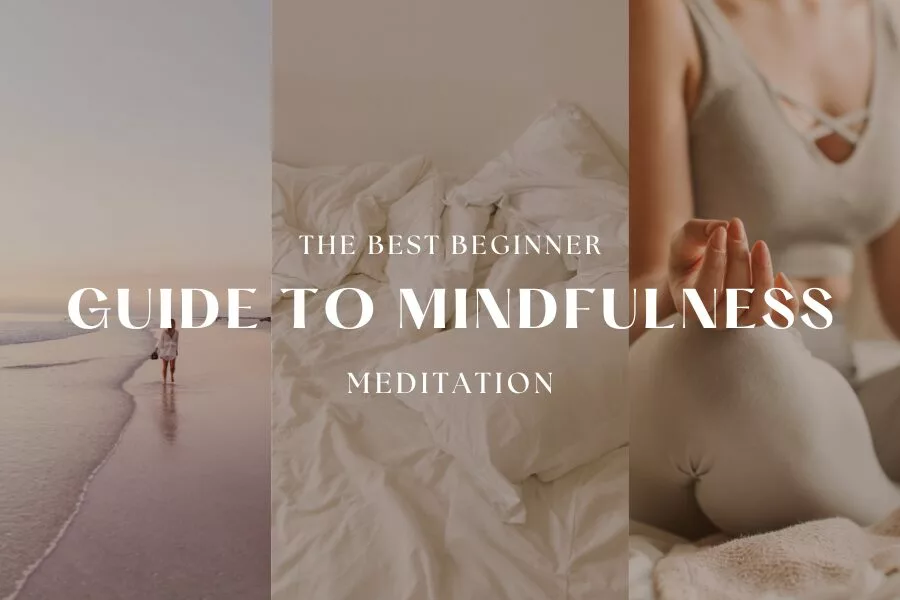
I recently hiked the Hollywood hills with a fairly large group. Chatting with one other person she admitted, “I hate slowing down. My mind is constantly racing with everything that needs to be done.” Intuitively I know this is a very common response to yin yoga, meditations, and sound healing. The art of stillness is not an easy one to master, yet our minds and bodies reap tremendous benefits when we practice.
In the quest for a calmer and more centered life, mindfulness meditation stands out as a beacon of tranquility. If you’re new to the practice and eager to unlock its transformative potential, you’re in the right place. Welcome to the best beginner guide to mindfulness meditation, where we’ll unravel the essentials of this ancient art, offering you a roadmap to embark on a journey toward inner harmony and peace.
In this article of mindfulness meditation for beginners you will learn how to meditate, be equipped with the best guided meditations for beginners, currate a sacred space for meditation, and mindful breathing technqiues for beginners.
By the end, you will be ready to reap the benefits of mindfulness meditation practice.
This article is all about mindfulness meditation for beginners.
Mindfulness Meditation For Beginners
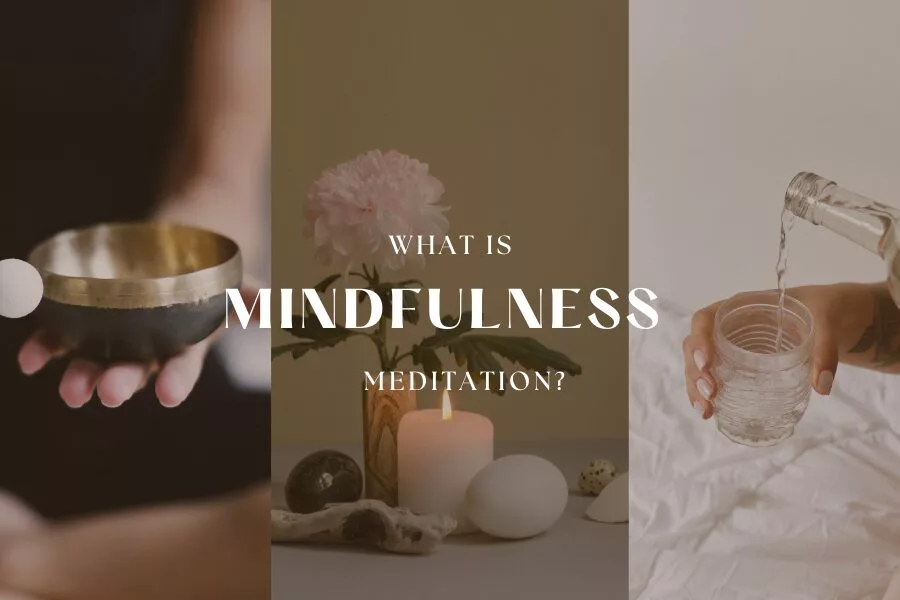
Section 1: Understanding Mindfulness Meditation
Let’s embark on your mindfulness meditation journey by gaining a profound understanding of its core principles.
Roots of Mindfulness:
Mindfulness meditation finds its roots in ancient contemplative traditions, particularly within Buddhism. Originating over 2,500 years ago, mindfulness, or “sati” in Pali, was a central component of the teachings of the Buddha. It was originally conceived as a path to enlightenment, with a focus on cultivating awareness and attention in the present moment.
Historical Significance:
Over the centuries, mindfulness transcended its religious origins, making its way into various cultures and secular practices. The integration of mindfulness into Western psychology gained momentum in the 20th century, notably through the work of pioneers like Jon Kabat-Zinn. His development of Mindfulness-Based Stress Reduction (MBSR) brought mindfulness into mainstream therapeutic settings, emphasizing its secular and universal applications.
Science Behind Mindfulness:
The scientific community has increasingly turned its attention to mindfulness meditation, conducting numerous studies that underscore its therapeutic benefits. Neuroscientific research reveals structural changes in the brain associated with enhanced attention, emotional regulation, and even changes in the size of the amygdala, a key player in stress response. Additionally, studies on the physiological level demonstrate the positive impact of mindfulness on reducing cortisol levels and promoting overall well-being.
The Go-To Practice for Mental Clarity and Emotional Well-being:
In a world marked by constant distractions and information overload, mindfulness meditation has emerged as a sanctuary for individuals seeking mental clarity and emotional balance. Its ability to cultivate a heightened sense of awareness allows practitioners to observe thoughts and feelings without judgment, fostering a non-reactive and centered mindset.
Integrating Mindfulness into Modern Life:
Beyond its historical and scientific underpinnings, mindfulness meditation addresses the contemporary challenges of stress, anxiety, and the fast-paced nature of modern living. By embracing mindfulness, individuals can navigate daily pressures with a greater sense of resilience, connecting with a profound source of calm amidst the chaos.
In essence, understanding mindfulness meditation involves appreciating its origins, recognizing its evolution, and acknowledging the empirical evidence that underscores its potential to transform lives. As we proceed in this exploration, you’ll discover practical tools and techniques that will empower you to embark on your own journey toward mindfulness and inner harmony.
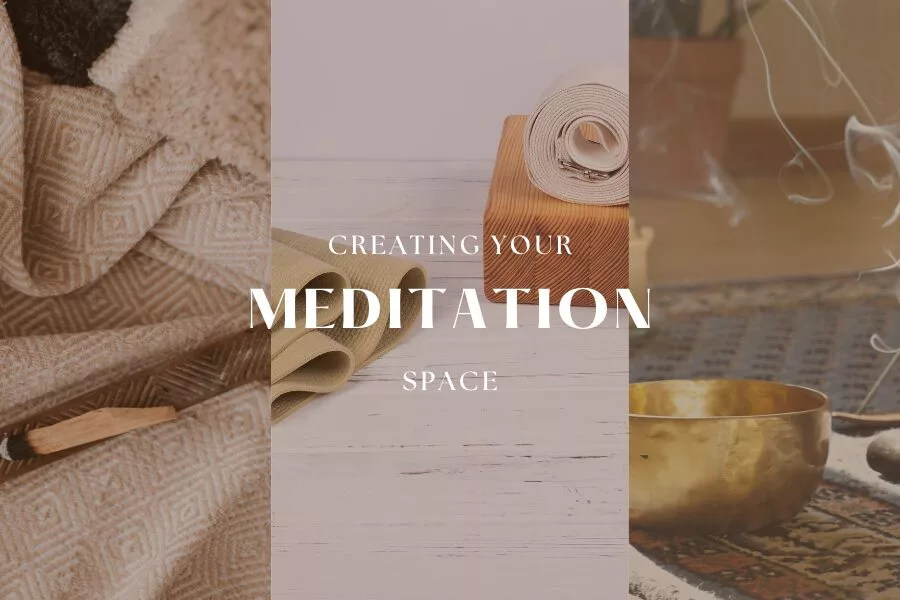
Section 2: Setting the Stage: Creating Your Meditation Space
As you step into the world of mindfulness meditation, the significance of your meditation space cannot be overstated. This sacred sanctuary becomes the canvas upon which your practice unfolds. Let’s explore the essential elements of crafting a meditation space that nurtures your journey toward inner peace.
Choosing the Right Location:
Selecting the perfect location for your meditation space is the first step in creating a haven for mindfulness. Ideally, choose a quiet and undisturbed area where you can immerse yourself in the practice without interruptions. Whether it’s a corner of a room, a cozy nook, or a spot in nature, the key is to find a space that resonates with tranquility.
Incorporating Calming Elements:
Transform your chosen space into a serene retreat by incorporating calming elements. Consider elements such as soft lighting, whether it’s natural sunlight or warm, gentle lamps. Introduce soothing colors, such as earthy tones or cool blues, to create a visually peaceful atmosphere. A comfortable cushion or chair can provide physical support, allowing you to relax into your meditation.
Meaningful Decor:
Personalize your meditation space with meaningful decor that inspires a sense of tranquility. This could include items like candles, essential oil diffusers with calming scents, or symbolic objects that hold significance for you. If you prefer, create an altar or surround yourself with crystals to assist with the intentions you set for your meditation. Keep the space uncluttered, allowing your mind to focus and unwind without distractions.
Decluttering the Mind and Space:
Just as your physical space needs to be decluttered, so does your mental space. Take a moment to clear your mind before entering your meditation space. This can be as simple as a few deep breaths or a brief moment to jot down your stressors to let go before entering the serenity of your practice.
Enhancing the Ambiance:
Consider incorporating ambient sounds or gentle music into your meditation space to enhance the overall ambiance. Nature sounds, soft instrumental music, or guided meditation tracks can create a harmonious background, helping you to relax and deepen your practice. Experiment with different sound bowls or chimes to find what resonates best with your personal preferences.
The Power of Consistency:
Consistency is key when it comes to creating your meditation space. By consistently using the same space for your practice, you build a psychological association between that space and the calm, centered state of mindfulness. This association makes it easier for your mind to enter a meditative state when you enter the designated area.
In essence, your meditation space becomes a sanctuary where you leave the outside world behind and connect with your inner self. By thoughtfully curating this space with intention and care, you set the stage for a more profound and transformative mindfulness meditation experience.
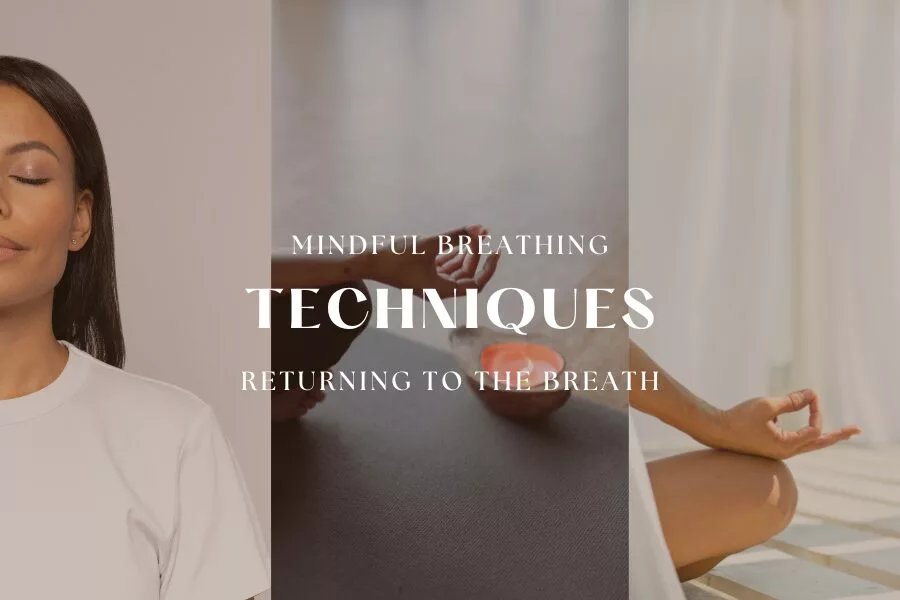
Section 3: Mindful Breathing Techniques for Beginners
At the heart of mindfulness meditation lies the art of mindful breathing—a fundamental practice that anchors you in the present moment and fosters a profound sense of mindfulness. In this section, let’s delve into beginner-friendly breathing techniques that serve as the foundation of your mindfulness practice.
Deep Belly Breathing (Diaphragmatic Breathing):
Begin your mindfulness journey with deep belly breathing. Find a comfortable seated position or lie down. Place one hand on your chest and the other on your abdomen. Inhale slowly through your nose, allowing your diaphragm to expand and your abdomen to rise. Exhale gently through your mouth, feeling your abdomen fall. Focus on the rise and fall of your breath, gradually slowing the pace for a calming effect.
Box Breathing (Square Breathing):
Box breathing is a simple yet effective technique to enhance concentration and relaxation. Inhale deeply for a count of four, hold your breath for four counts, exhale for four counts, and then pause for another four counts before repeating. Visualize each side of the breath cycle forming a square. This technique can be practiced anywhere and is particularly useful for managing stress and anxiety.
4-7-8 Breathing (Relaxing Breath):
Developed by Dr. Andrew Weil, the 4-7-8 breathing technique is renowned for inducing a sense of calm. Inhale quietly through your nose for a count of four, hold your breath for seven counts, and exhale completely through your mouth for a count of eight. Repeat this cycle at least four times. This technique helps regulate the nervous system and promotes relaxation.
Mindful Breath Awareness:
Shift your attention to the natural rhythm of your breath. Find a comfortable position, close your eyes, and bring your awareness to the sensation of breathing. Notice the coolness of the inhale and the warmth of the exhale. Allow your breath to flow naturally without forcing it. When thoughts arise, gently redirect your focus to the breath. This practice enhances present-moment awareness and mindfulness.
Alternate Nostril Breathing (Nadi Shodhana):
This yogic breathing technique balances the left and right sides of the brain, promoting a sense of equilibrium. Sit comfortably and use your right thumb to close off your right nostril. Inhale through your left nostril, then close it with your right ring finger. Release your thumb and exhale through the right nostril. Inhale through the right nostril, close it, release the left nostril, and exhale. Repeat this cycle.
Body Scan Breathing:
Combine mindfulness with a body scan by directing your breath to different parts of your body. Inhale, directing your breath to a specific area, and as you exhale, release any tension or tightness in that area. Gradually move through each part of your body, cultivating a deep sense of relaxation and awareness.
By incorporating these mindful breathing techniques into your daily routine, you lay the groundwork for a transformative mindfulness practice. Experiment with different techniques to discover which resonates best with you, and enjoy the calming and centering effects of mindful breathing.
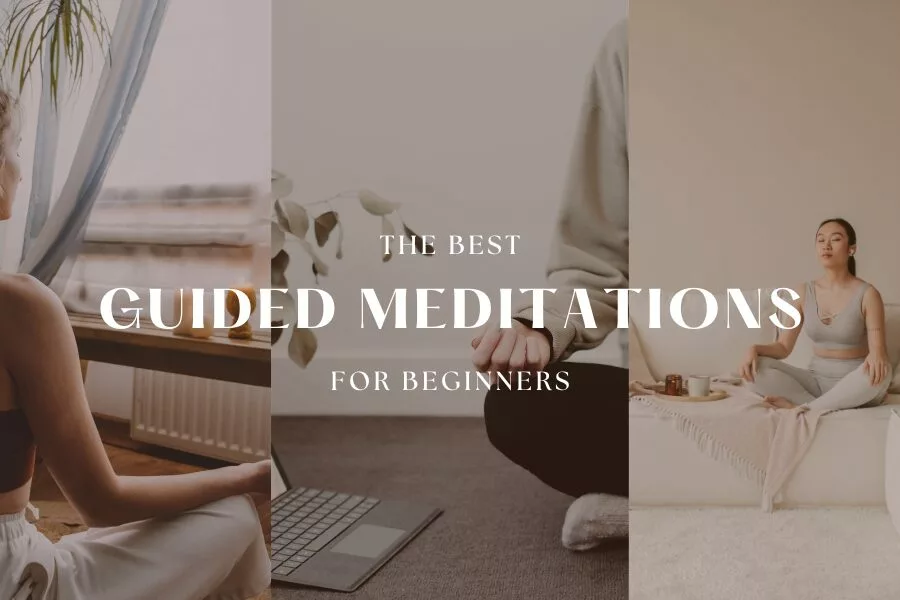
Section 4: Best Guided Mindfulness Meditation For Beginners
Guided meditations serve as a gentle entry point for beginners, offering structured support as you embark on your mindfulness journey. Let’s navigate the world of guided sessions tailored specifically for novices, exploring popular apps and resources that provide step-by-step guidance, making meditation easily accessible and enriching for beginners.
Understanding Guided Meditation:
Guided meditation involves a narrator or instructor leading you through a meditation session, offering prompts and suggestions to help you focus and relax. This form of meditation is particularly beneficial for beginners, providing a structured approach that eases the process of cultivating mindfulness.
Headspace:
Headspace is a widely acclaimed meditation app that caters to individuals at all levels, including beginners. With its user-friendly interface, Headspace offers guided meditations on various themes, such as stress reduction, sleep improvement, and enhancing focus. The app’s approachable animations and diverse meditation sessions make it an excellent starting point for those new to mindfulness.
Insight Timer:
Insight Timer stands out as a versatile meditation app that not only provides guided sessions but also offers a community aspect. Beginners can explore a vast library of guided meditations led by experienced instructors, covering topics like mindfulness, self-compassion, and relaxation. The app’s timer feature also allows for self-guided meditation sessions as you progress in your practice.
Calm:
Calm is another highly popular meditation app that caters to beginners with its soothing guided sessions. From guided breathing exercises to mindfulness meditations, Calm offers a variety of options to suit different preferences. The app’s Sleep Stories and nature sounds provide additional relaxation options, making it a comprehensive resource for those new to meditation.
YouTube Channels:
YouTube is a treasure trove of guided meditation resources for beginners. Channels like “Meditative Mind,” and “The Psychic Soul” feature a wide range of guided sessions, from short mindfulness exercises to longer meditations for relaxation and stress relief. Explore and find instructors whose guidance resonates with you.You can always check out our free guided meditations here.
Mindful.org:
Mindful.org is a website that offers a wealth of mindfulness resources, including guided meditations. Tailored specifically for beginners, these guided sessions cover fundamentals like mindful breathing, body scan meditations, and loving-kindness practices. The website also provides articles and tips to support your mindfulness journey.
Local Meditation Classes:
Consider exploring local meditation classes or workshops conducted by experienced instructors. Many communities offer introductory classes for beginners, providing an opportunity to learn meditation techniques in a supportive and interactive setting. I’ll be reviewing local meditation groups in Los Angeles and New York City, join the newsletter to stay tuned for those!
Incorporating guided meditations into your routine as a beginner can significantly enhance your mindfulness experience. Experiment with different apps, resources, and instructors to find the guidance that resonates with you, and enjoy the enriching journey of self-discovery and inner peace.
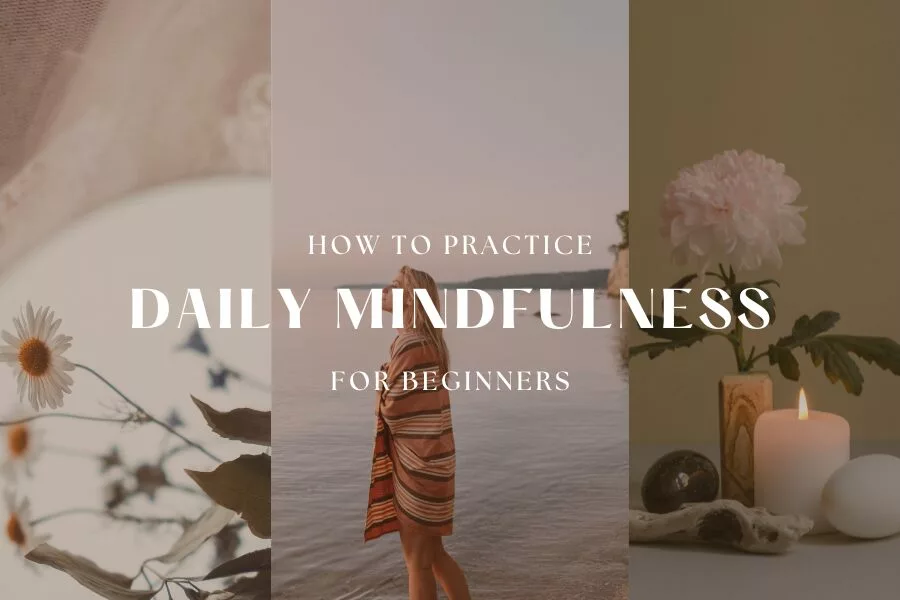
Section 5: Cultivating Mindfulness in Daily Life
As you embrace mindfulness meditation, the practice extends beyond the cushion or meditation space—it becomes a way of life. In this section, let’s explore practical tips for seamlessly integrating mindfulness into your daily routine. From mindful eating to infusing mindfulness into mundane activities, these small shifts can lead to significant changes in your overall well-being.
Mindful Morning Rituals:
Start your day with intention by incorporating mindfulness into your morning routine. Rather than rushing through tasks, take a moment to savor your morning coffee or tea. Practice mindful breathing as you shower or engage in simple stretches, grounding yourself in the present moment before the day unfolds.
Mindful Eating:
Transform mealtime into a mindful experience by paying full attention to your food. Engage your senses—observe the colors, textures, and aromas. Chew slowly and savor each bite. By being fully present during meals, you not only enhance your digestion but also cultivate a deeper connection with the nourishment your body receives.
Mindful Movement:
Infuse mindfulness into your daily movement, whether it’s walking, commuting, or exercising. Instead of letting your mind wander, focus on the physical sensations of each step or movement. Feel the ground beneath you, the rhythm of your breath, and the sensation of your body in motion. This simple shift can turn routine activities into opportunities for mindfulness.
Mindful Work Breaks:
During work breaks, step away from your desk and practice a brief mindfulness exercise. Whether it’s a short breathing meditation, a mindful walk around the office, or a moment of conscious stretching, these mini-breaks can recharge your mind and improve overall focus and productivity.
Mindfulness in Communication:
Extend mindfulness to your interactions with others. Practice active listening during conversations, fully engaging with what the other person is saying without distractions. Be aware of your own responses and choose words mindfully. This fosters deeper connections and promotes a more positive and compassionate communication style.
Mindfulness in Everyday Tasks:
Turn routine chores into opportunities for mindfulness. Whether you’re washing dishes, folding laundry, or cleaning, focus your attention on the task at hand. Feel the sensations, notice the movements, and embrace the simplicity of the activity. Mundane tasks become a canvas for mindfulness when approached with presence.
Mindful Evening Reflection:
Conclude your day with a brief mindful reflection. Take a few moments to acknowledge and appreciate the positive aspects of your day. Reflect on challenges with a non-judgmental mindset, considering what you’ve learned. Engage in a calming meditation before bedtime to transition into a restful and mindful night’s sleep.
By infusing mindfulness into your daily life, you create a seamless connection between formal meditation sessions and the ebb and flow of your everyday experiences. These small, intentional shifts have the power to transform your perception of the world around you, leading to increased joy, resilience, and a profound sense of well-being.
As you embark on this transformative journey into mindfulness meditation, remember that every breath is a step closer to inner harmony. This comprehensive beginner’s guide has equipped you with the knowledge and tools needed to embark on this enriching path. Embrace each moment, be patient with yourself, and watch as mindfulness meditation unfolds its magic, bringing peace, clarity, and a renewed sense of balance to your life.
This article was all about Mindfulness Meditation for Beginners.





